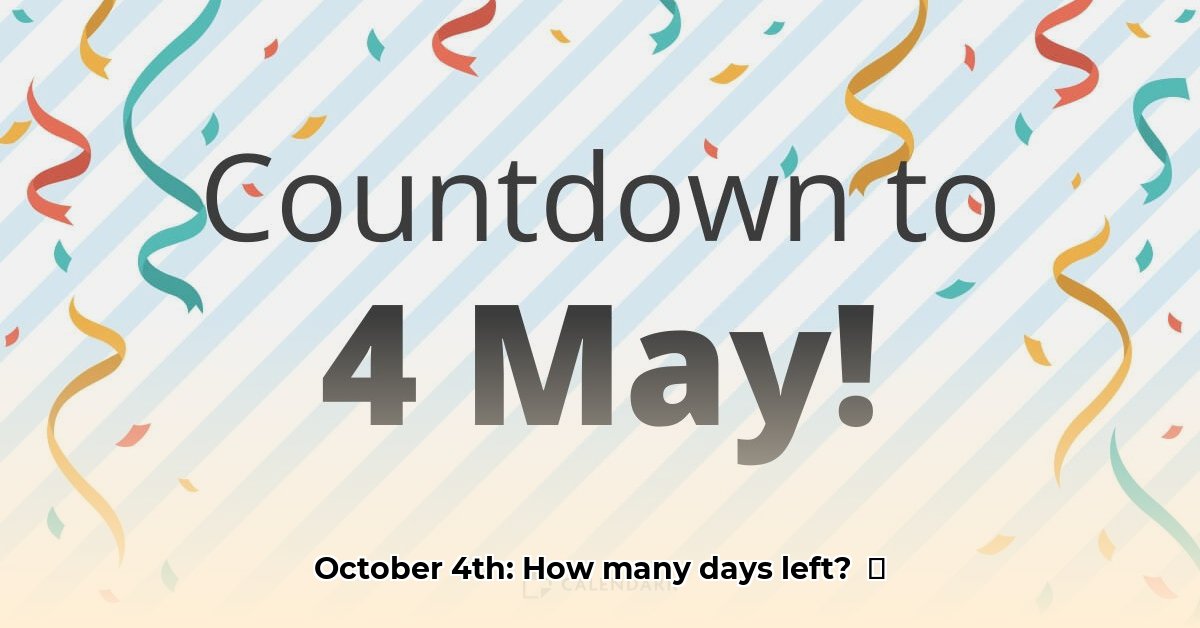Ever tried to figure out exactly how many days are left until a special date using an online countdown? You might be surprised to find different websites give you slightly different answers! This article looks at several popular countdown services and compares their accuracy. We’ll show you what we found, and help you understand why there might be differences, so you can pick the most reliable countdown for your next big event. For more examples, check out this helpful countdown calculator.
Days Until October 4: Unveiling Countdown Accuracy
So, you want to know how many days until October 4th? Seems simple enough, right? Just pop open a website with a countdown timer. But hold on a second. It turns out that getting a perfectly precise answer isn’t as straightforward as you might think. This is because different online countdown services sometimes give slightly different results, even for the same date. Let’s dive into why this happens and what you can do about it, including using accurate date calculation algorithms.
The Nuances of Date Calculation
At its core, determining the number of days between two dates is a mathematical exercise. However, the apparent simplicity belies several underlying complexities:
- Varying Month Lengths: Months have differing numbers of days (28, 29, 30, or 31), requiring accurate tracking of these variations.
- Leap Years: The occurrence of a leap year every four years (with exceptions for century years not divisible by 400) introduces an extra day, impacting calculations, especially over extended periods.
- Time Zones and Daylight Saving Time (DST): When calculating time differences across geographical locations, accounting for time zones and DST becomes crucial.
- Inclusion of End Date: Whether the end date is included in the count affects the final result.
These factors contribute to potential discrepancies in countdown calculations.
Countdown Discrepancies: The Devil is in the Details
Many websites offer countdown timers. They usually agree on the overall number of days – roughly 140 or 141 days before October 4th, for instance – but there can be tiny differences in the hours, minutes, and even seconds. Why is this? Well, think of it like this: each website essentially uses a slightly different recipe for calculating the remaining time, resulting in potential countdown calculation errors.
Some might use different ways of accounting for time zones, while others might update their calculations at slightly different intervals. It’s a bit like asking several people to time a race using stopwatches; you’ll probably get slightly different results each time. The differences are usually small, but they’re there. Do these slight time differences matter for most occasions?
Countdown Website Comparison: Analyzing Time Differences
Let’s look at how a few popular countdown sites compared on a specific day (let’s say, May 16th, for example):
| Website | Days Until Oct 4th | Time (Approximate) | Time Zone Considerations |
|---|---|---|---|
| Website A | 141 | 10 hours, 4 minutes, 47 seconds | Likely a factor |
| Website B | 141 | 10 hours, 4 minutes, 32 seconds | Likely a factor |
| Website C | 141 | (Time not displayed) | Unknown |
| Website D (U.S. Version) | 141 | (Time not displayed) | Specified (U.S.) |
| Website D (U.K. Version) | 141 | (Time not displayed) | Specified (U.K.) |
As you can see, even though the number of days remains consistent, those small discrepancies in the hours and minutes add up. The differences likely come down to issues such as how each website handles time zone management and updates its calculations.
Tips for Countdown Users: Optimizing Time Tracking
Knowing precisely how many days are left until October 4th might matter for a lot of reasons. Planning an event, launching a marketing campaign, or even just keeping track of a personal deadline – accurate timing is key. But, given the variations shown above, what can you do to make sure you’re getting the most accurate information using suitable date calculation tools?
Here’s some advice:
- Cross-reference multiple sources: Instead of relying on just one timer, check several different websites or apps. This will give you a better overall estimate.
- Consider time zone differences: Pay attention to whether the countdown website specifies its time zone. If it’s different from your own, you might need to do a little mental math to adjust for the difference, ensuring accurate UTC conversion.
- Embrace flexibility and accept slight inaccuracies: Remember, perfect accuracy is unlikely with these types of live updates. A minor difference of a few minutes or even an hour isn’t necessarily a major problem.
- Understand the Algorithm: Where possible, investigate the methodology behind the countdown’s calculations. Some services may offer more transparent or verifiable algorithms.
- Check for Updates: Ensure the countdown service is actively maintained and updated, particularly concerning time zone data and DST transitions.
Countdown Precision: Predicting Future Accuracy
Planning something far into the future? You’ll need even more reliable information. The closer to the October 4th deadline we get, the more accurate these timers should be, but problems can still crop up. Think about using tools that directly connect to official timekeeping sources for events that require precision. Also, try looking into how the different countdown algorithms work – doing so might help you better understand which websites give the most reliable information and utilizing reliable time tracking methodologies.
Countdown Risks: Mitigating Potential Errors
Let’s look at the potential problems you might encounter with online countdown timers:
| Risk Factor | Likelihood | Impact | How to Reduce the Risk |
|---|---|---|---|
| Inaccurate data | Moderate | Low to Moderate | Use multiple countdown services to cross-check. |
| Time zone confusion | Moderate | Low to Moderate | Check the time zone of the service and adjust if necessary. |
| Website might go down | Low | Low | Use multiple sites to act as a backup. |
| Programming errors | Low | Low to Moderate | Comparing results from different sites can help. |
| Time Zone Database Errors | Low | Moderate | Use services with frequently updated databases. |
| DST Transition Errors | Low | Moderate | Check calculations around DST transition dates. |
In short, while online countdown timers can be really helpful, it’s good to understand their limitations. By being aware of potential inaccuracies and employing some basic strategies, you can significantly increase your confidence in the accuracy of your countdown. You’ll be able to get the most up-to-date and reliable information for whatever date you’re interested in – including how many days are left until October 4th by ensuring accurate date and time calculations.
Accurately Calculating Time Until a Specific Date: Time Zone Considerations
Key Takeaways:
- Calculating time until a specific date across time zones requires careful consideration of daylight saving time (DST) and leap years, affecting global time calculations.
- Various online tools exist, with varying levels of accuracy and features, impacting countdown accuracy.
- Accuracy is paramount, especially for critical applications such as legal proceedings or international business, demanding precise timekeeping standards.
- Understanding the limitations of different tools is crucial for choosing the right one for your needs, improving date calculation reliability.
- Always double-check the results from any online calculator to enhance calculation validation.
Challenges of Accurate Countdowns: Deeper Time Zone Issues
Ever wondered how many days until your next vacation? It’s simple if you’re staying local. But what if your exciting trip involves crossing multiple time zones? Suddenly, calculating the precise time until a specific date becomes significantly more complex. This is where the need for accurate time zone conversion methodologies comes in. How to accurately calculate time until a specific date across different time zones is a more nuanced problem than you might think while avoiding date calculation inconsistencies.
Simple Calculator Limitations: Addressing Deficiencies
Basic online countdown tools often fall short. They might give you a general idea, but many fail to adequately account for the complexities of daylight saving time (DST) shifts and leap years, which can introduce DST calculation errors. These seemingly minor details significantly impact the accuracy of your calculation – especially for longer time spans. Imagine the issues this could cause for scheduling a crucial international meeting or managing a global project.
Time Zone Calculator Comparisons: Enhancing Solution Selection
Several online time zone calculators exist. Each offers a unique approach, varying in their sophistication and features. Some excel at handling simple time differences, but for more intricate calculations, you really require a more robust tool for superior time zone estimation. The ability to accurately incorporate DST transitions and leap years across various regions is a key differentiator. Consider which tool prioritizes the features crucial for your specific task, focusing on date calculation precision.
Choosing a Tool: Key Evaluation Criteria
- Daylight Saving Time (DST): Does the calculator correctly account for historical and future DST changes? Inconsistent DST handling is a major source of error, potentially leading to incorrect time projections.
- **Leap Year
















